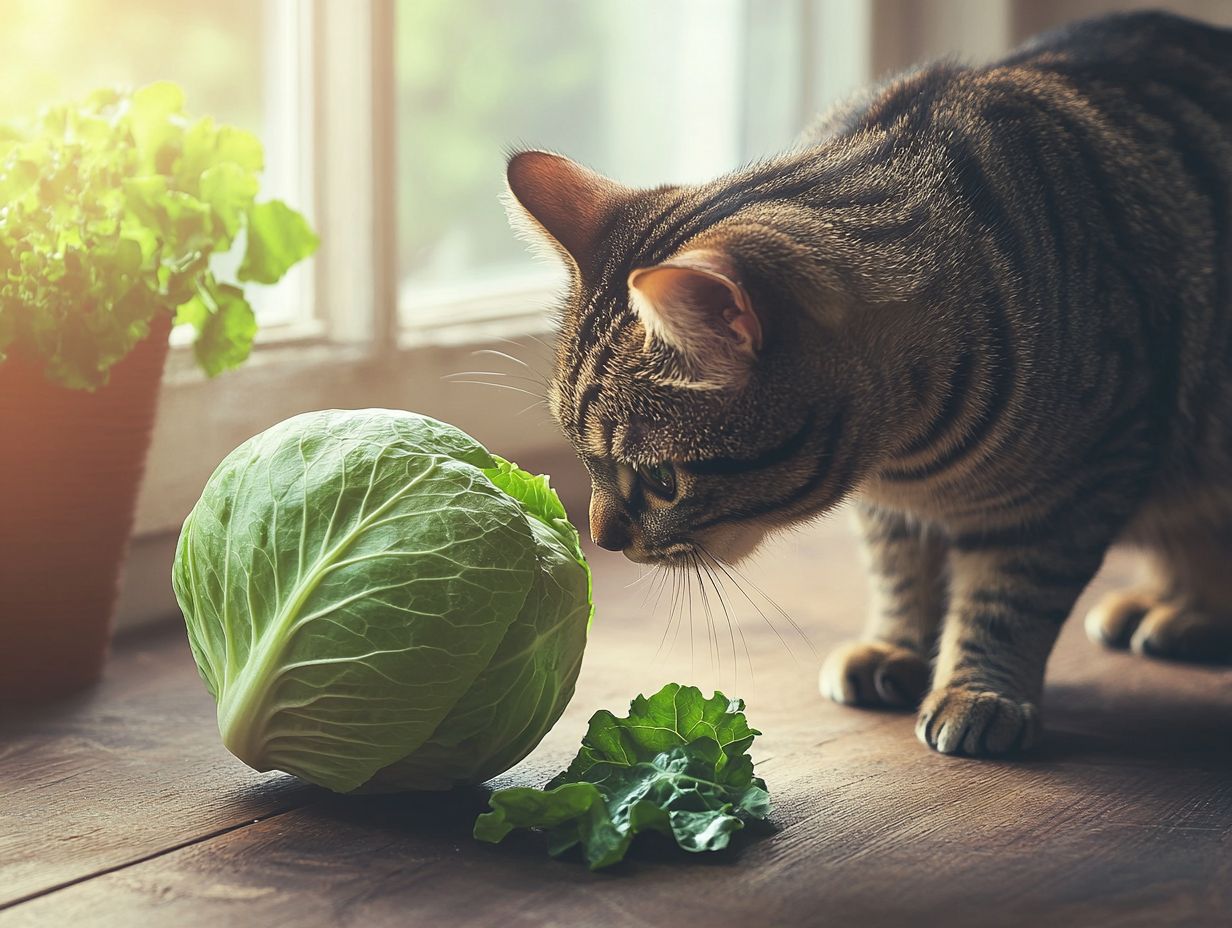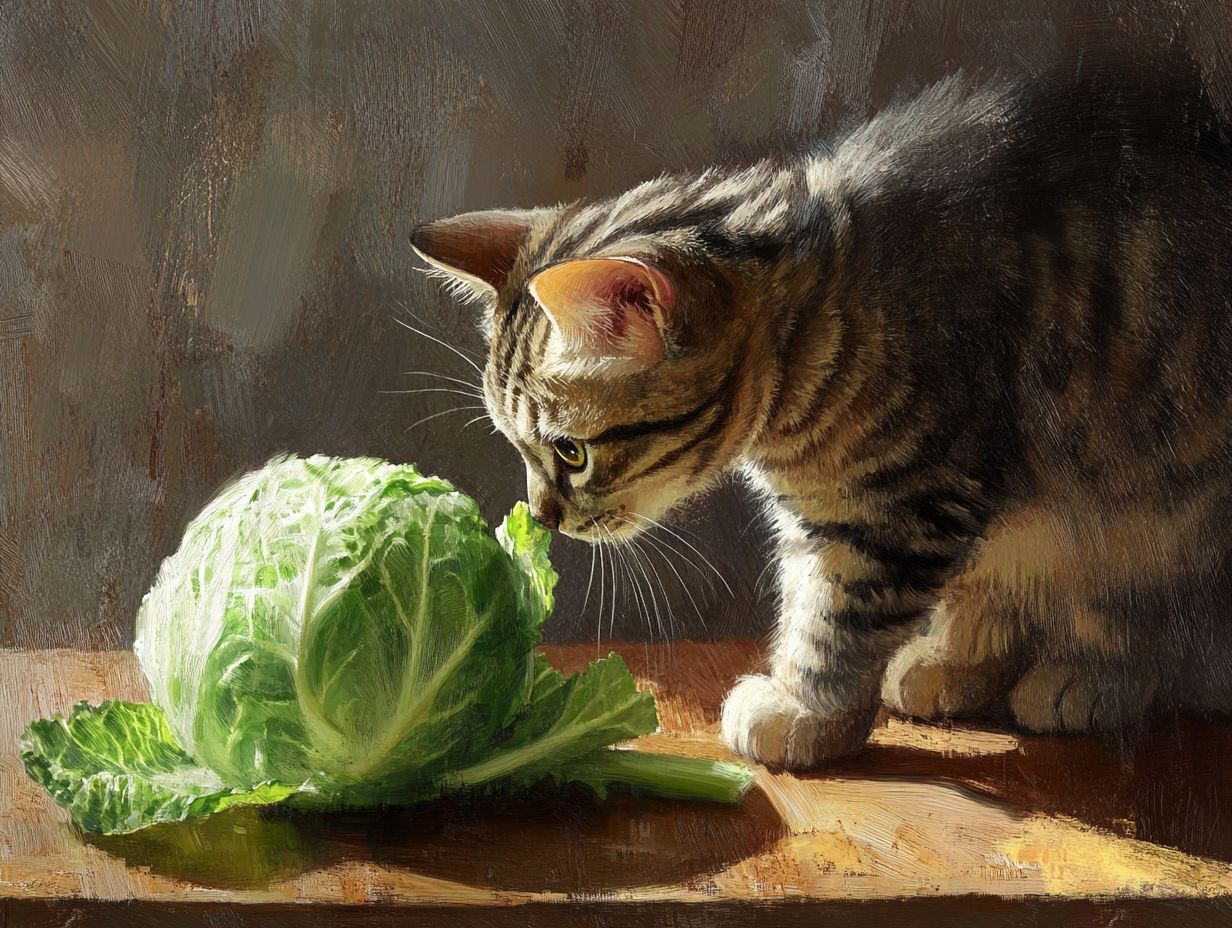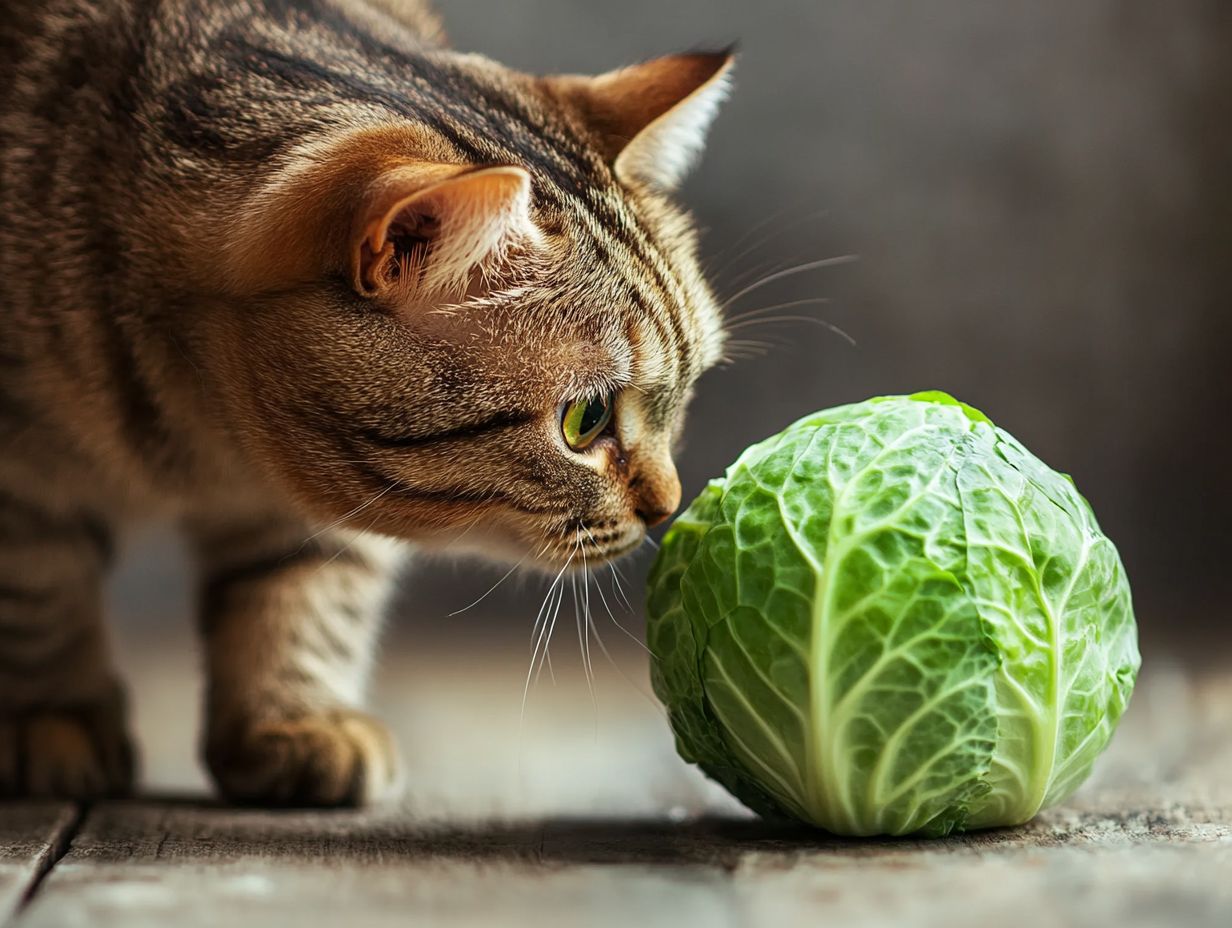Curious about whether your feline friend can enjoy cabbage? This piece unpacks the nutritional value of cabbage for cats while highlighting potential risks to be aware of.
Essential factors to consider before adding it to your cat’s diet are discussed, along with safe alternatives such as zucchini and carrots. If you do decide to introduce cabbage, tips on how to do it properly will be shared.
Read on to make informed choices for your cat’s health and happiness!
Key Takeaways:

- Cabbage can be a nutritious addition to a cat’s diet, but it should not be the main source of food. Moderation is key.
- Certain factors, such as allergies and pre-existing health conditions, should be considered before feeding cabbage to your cat.
- There are plenty of safe and healthy alternatives to cabbage that can provide similar nutritional benefits for cats.
Cabbage and Cats: What You Need to Know
Cabbage and cats are connected through the curiosity of pet owners who may wonder if cabbage is safe for their feline companions. Cabbage is a nutrient-rich vegetable often lauded for its health benefits, containing various vitamins and minerals.
However, it is essential to determine whether cabbage is safe for cats, given that some vegetables can be toxic to pets. This article will explore the nutritional benefits of cabbage, potential risks, and alternative vegetables that are safe for cats.
Benefits of Cabbage
Cabbage offers various nutritional benefits, which can be advantageous for cats and dogs when properly incorporated into their diets. The vitamins K and C in cabbage play crucial roles in supporting pets’ immune systems and aiding in blood clotting.
Vitamin K is essential for bone health, while vitamin C is vital for immune function and acts as a powerful antioxidant. Additionally, the dietary fiber in cabbage promotes digestive health and can help prevent diarrhea or constipation.
Pet owners should introduce cabbage in moderation, as excessive amounts may lead to gas or digestive discomfort. Leafy green vegetables such as spinach, broccoli, and kale also provide similar benefits, making them good alternatives to include in a pet’s diet.
Potential Risks of Feeding Cabbage to Cats
Cabbage can offer some health benefits for cats, but it also poses certain risks. Incorporating cabbage into a cat’s diet may lead to gas, bloating, and other gastrointestinal issues.
This discomfort arises from certain compounds that can adversely affect healthy thyroid function if consumed in excess. Some cats may experience reactions like vomiting or diarrhea, highlighting the importance of monitoring for any negative effects after feeding them cabbage.
Additionally, other vegetables commonly found in human diets, such as onions and garlic, can pose serious health risks to cats, making careful selection of ingredients essential.
Can Cats Eat Cabbage?

The question of whether cats can eat cabbage is relevant for many pet owners. Cabbage can be offered in small amounts, but it should not be a staple in their diet.
Factors to Consider
- Overall health of the individual cat.
- Possible allergies or dietary restrictions.
- Monitoring behavior and physical condition after introducing cabbage.
Consulting a veterinarian is essential, as they can offer valuable guidance and monitor for any adverse reactions, ensuring that the introduction of cabbage and other new foods is beneficial rather than harmful to the animal.
Portion Sizes and Frequency
When introducing cabbage, moderation is crucial. Aim to offer cabbage:
- 1-2 times a week.
- A small piece, about 1 tablespoon for a medium-sized cat.
Alternatives to Cabbage for Cats
There are several other safe vegetables that provide similar nutritional benefits to cabbage for cats, while posing fewer risks if cabbage is deemed inappropriate for them.
Safe and Healthy Options for Feline Diets
Consider offering alternatives like carrots, green beans, and sweet potatoes, which are not only safe but also nutritious for cats.
How to Prepare Cabbage Safely
If you decide to introduce cabbage, follow these tips:
- Cook or steam the cabbage to make it easier for your cat to digest.
- Offer a small piece, about 1 tablespoon for a medium-sized cat.
- Monitor your cat for any signs of discomfort or adverse reactions.
Warning: Symptoms of Adverse Reactions
Be aware of potential symptoms such as:
- Vomiting
- Diarrhea
- Gas or bloating
If any of these occur, contact your veterinarian immediately.
Conclusion
In summary, cabbage can be introduced to your cat’s diet but should always be done in moderation. Remember to consult with your veterinarian to ensure that this addition is beneficial for your pet’s health.
Here are some safe vegetables for cats, along with their health benefits, that can help keep your feline friend healthy. However, these vegetables should only be offered in moderation:
- Spinach: Supports good digestion and enhances immune function.
- Zucchini: Aids in weight management and provides hydration.
- Pumpkin: Regulates digestion and supports eye health.
To incorporate these vegetables safely, steam or puree them before mixing them into your cat’s regular food. This preparation makes them easier to digest and adds nutritional value. Offer no more than 1-2 teaspoons of pureed vegetable per meal to start. For more information on this topic, check out Can Cats Eat Cabbage? Is It Safe for Felines?.
How to Safely Introduce Cabbage to Your Cat’s Diet

Cats can eat cabbage; however, it is important to introduce it to their diet gradually and carefully to monitor for any adverse reactions. Keeping a food diary can help track any changes in behavior or health.
Tips for Incorporating Cabbage into Cat Food
Proper preparation is key to ensuring both the safety and palatability of cabbage for your cat. Cooking the cabbage correctly—steaming or boiling—can help break down potential toxins and make the cabbage easier for cats to digest.
Combining cabbage with other safe vegetables, such as carrots or peas, can create a nutrient-rich blend that is more appealing to cats and can be used in homemade cat food recipes. These mixtures may be prepared at home or found in commercially available cat food brands that include cabbage as an ingredient.
As with any new food, it is important to introduce cabbage slowly and carefully, while closely monitoring for any negative reactions. Signs of potential adverse reactions include:
- Vomiting
- Diarrhea
- Lethargy
Final Thoughts and Recommendations
Yes, cabbage can be beneficial for cats to some extent, offering health benefits like essential vitamins. However, it is not a necessary part of a cat’s diet, and it is important to weigh the risks against the benefits and minimize those risks. Failing to understand the potential dangers of feeding cabbage to cats—such as the possibility that overconsumption can lead to digestive issues or more serious health problems—can negatively affect their well-being.
Those considering adding cabbage to their cat’s diet should consult with a veterinarian to determine if it is appropriate and to what extent. Safer alternatives, such as cooked carrots or peas, offer similar benefits.
Cabbage for Cats: Health Benefits and Risks
Frequently Asked Questions
Can cats eat cabbage?

Yes, cats can eat cabbage, but it should only be an occasional treat.
Is cabbage safe for felines?
In small amounts, cabbage is generally safe for cats to eat. However, it should not be a staple food in their diet.
What nutrients does cabbage provide for cats?
Cabbage contains vitamins K, C, and B6 which can be beneficial for cats in small amounts.
Can too much cabbage be harmful for cats?
Yes, consuming a large amount of cabbage can cause digestive issues such as bloating and gas for cats.
Are there any potential risks in feeding cabbage to cats?
Raw cabbage contains a compound called thiocyanate which can interfere with thyroid function in cats. Cooked cabbage may also cause digestive issues. It is best to avoid feeding cabbage to cats.
What are some alternative vegetables cats can eat?
Cats can safely consume small amounts of cooked green beans, peas, and carrots, along with more adventurous options like asparagus and butternut squash. It is important to always check with your veterinarian before introducing new foods to your cat’s diet.
Always prioritize a balanced diet and consult with your veterinarian when introducing new foods.